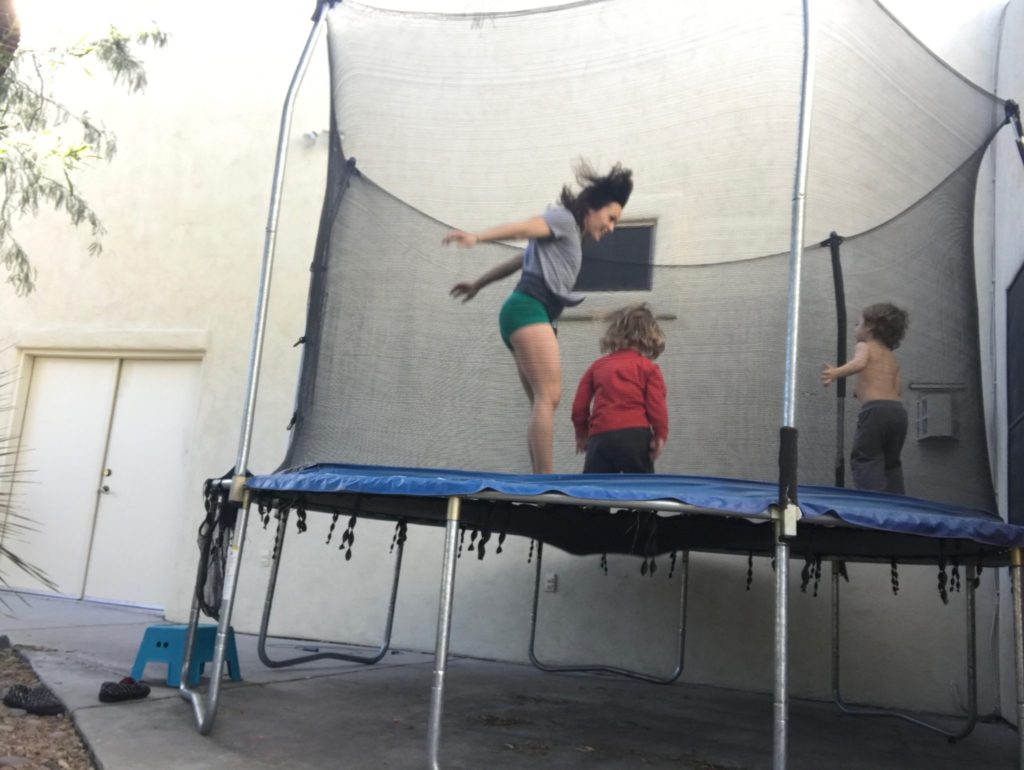It’s the mom sneeze. You feel that tingle in your nose, so you say three Hail Marys, squeeze…squeeze…squeeze, and clinch those thighs in the hopes that you don’t wet your pants. And you know damn well that the look upon your face gives away just which way the chips fell.
I’m here to tell you that stress urinary incontinence (SUI)—or simply put, leaking urine with physical activity, coughing, laughing or sneezing—is not simply the price of motherhood. Diastasis recti, an abdominal separation common after pregnancy that leaves you with an unrelenting “mommy tummy” and back pain, is not the price of motherhood. Painful sex, low back pain, bladder urgency, perineal pain, pelvic pain, anal incontinence, and pelvic organ prolapse…all NOT THE PRICE OF MOTHERHOOD.
Stretch marks—own it. Lose skin—rock it. Saggy boobs—well, we aren’t in college anymore, are we? But for the love of all things sacred, please don’t spend the rest of your life coping with postpartum side-effects that you CAN improve.
After talking to two pelvic floor experts, here’s what they want you to know if you are a mom, mom-to-be, or well…have a vagina.
1) Long lasting pain is NOT normal after child birth (or ever). Don’t settle for it.
Moms have an innate toughness that rivals even the most powerful superhero. We push through discomfort, always too busy focusing on everyone else around us to address our “pesky” postpartum issues. And even if you are proactive in seeking help, many obstetricians dismiss concerns, or simply aren’t aware of where to send patients with troubling postpartum symptoms. Frankly, the standard of postnatal care is often a simple dismal of the problem altogether, labeling it as nothing more than a “side-effect of motherhood.”
So we go about our lives, watching our kids jump on the trampoline from the sidelines. We skip that run we once enjoyed with friends. We quit going to weightlifting classes because we don’t have the core strength anymore. We dread intimacy, not because our husband farts in bed, but because it really hurts. We give up important parts of our lives all in the name of “motherhood.”
“When you can’t do the things that make you—you—it starts chipping away at pieces of us that make us who we are…the pieces that make us more than just moms,” says Sara Reardon, a pelvic floor physical therapist specializing in prenatal and postpartum issues. “Intimacy with your partner is important. Playing a sport you enjoy, or running, or dancing—it is important. You shouldn’t be shutting down areas of life that are important just because you had a baby.”
And you don’t have to!
There are resources that can help you gain function and ease discomfort. Seek a pelvic floor physical therapist in your area. Find one here.
“Pain is not normal. Just because it is common does not make it normal, and it doesn’t mean you can’t get help. There are so many things that can be done to improve your condition,” says Reardon. “It’s not just about getting your vagina back in shape. It is about taking back your life.”
2) You likely aren’t pissing yourself because you didn’t kegel enough.
I know you heard it like a million times during pregnancy, read it in all your pregnancy books, and it was probably the only piece of postnatal advice you got from your obstetrician. Kegel it up, and you’ll have a vagina of gold after you pop that baby out. Now you are blaming yourself. “I didn’t do them enough,” you sob, as you pee yourself on your morning run.
Throw that blame out the window, and most likely those kegels can go right along with it.
A kegel is a muscular contraction (think stopping urine mid-stream), and it can be useful in some instances, but contracting these muscles can make the muscle tighter and this isn’t always a good thing. And, might I add, tighter doesn’t mean more functional. I know what you’re thinking, “Anything tighter down there must be better.”
Here’s the deal. Your pelvic floor is comprised of a group of muscles that never completely relax, or we’d be incontinent, so if you add kegel exercises to an already tight pelvic floor, it can cause or worsen dysfunction.
“Imagine if you are flexing your biceps all day and someone said, ‘Here, take these dumbbells and do curls.’ Your biceps would be ‘pumped up’ and fatigued, and will lose function more rapidly. Your pelvic floor is comprised of muscles that are always working, and weakness can be a result of too much tension,” says Diana Fassett, pelvic floor physical therapist and owner of Success Physical Therapy. “The pelvic floor can hold a lot of the body’s tension, especially in a high stress person. So the cause of urinary leakage could actually be pelvic floor muscle tension or tightness.”
Kegels have their place, but the only way to know if they are appropriate is to be evaluated by a pelvic floor physical therapist. Unless you’ve been told that your pelvic floor is weak—not tight—then don’t try to break any kegel records. Instead, focus on learning to coordinate your transverse abdominis (those deepest abdominal muscles) with your pelvic floor and glutes. Learning to coordinate your breath with your pelvic floor in moments of exertion can help. Of equal importance, you need to know how to relax your pelvic floor muscles. It’s not simple, so getting assessed, if possible, is the best course of action.
Know you aren’t alone–50-70% of women experience stress urinary incontinence, according to Fassett, and not necessarily as a result of childbearing.
3) Train for pregnancy and motherhood like you would a marathon.
Think about pregnancy and birth as an athletic feat, because that’s exactly what it is. Many countries recognize it as such, providing pelvic floor perinatal health, and statics have shown it shortens the length of labor, prevents long-term complications postpartum, and reduces the incidences of c-section. (But who really needs it, right?) Because pelvic floor health isn’t commonplace, it is up to you to be proactive. If you are pregnant, or newly postpartum, or having lingering issues, ask for a referral to a pelvic floor physical therapist. Advocate for yourself.
According to Reardon, labor is even harder on a woman’s pelvic floor nowadays with the high use of induction drugs, and epidurals, which often result in a longer second stage of birth. Couple that with improper pushing techniques and positioning, and the pelvic floor can really suffer. Learning how to use your body is an important tool for childbirth.
Are you thinking of getting pregnant again? Then you want to get your pelvic floor back in shape before you have another pregnancy.
“Don’t put the problem off until you are done having kids. You want to be strong if you are going to run that next marathon. That takes training and preparation,” Reardon says. “If you don’t address your postpartum problems and put it off until you are done having children, you could be making the issue worse in the long-run.”
4) A c-section is a major abdominal surgery…treat it as such.
C-sections are absolutely not the “easy way out.” Any woman who has heard the staple gun firing as she lay on a table with a blue drape protecting her view knows that it is an intense and invasive surgery. Simply because it is commonplace, doesn’t lessen the extremity of the toll it takes on our body.
Here’s the real kicker. If you think your pelvic floor is safe because you didn’t give birth vaginally—think again. Scar tissue from a c-section can impair pelvic floor function. Adhesions can affect the colon, bladder, and cause blood supply issues that cause pelvic pain.
“You wouldn’t get ACL surgery and not get rehab. C-sections are major abdominal surgery. It should be treated as such,” Reardon says. “It should be an absolute standard of care that a woman who has experienced a c-section be provided with pelvic floor physical therapy at 6-weeks postpartum.”
Learning to do scar manipulation—in other words: pushing, pulling, pinched, rolling, and rubbing you scar in an effort to redirect the fibers of the scar tissue—can help minimize adhesions and restore blood flow.
If you’re like me, just the thought makes you cringe. This is because that area is sensitive due to restricted blood flow. Unlike most pain, feeling uncomfortable during scar mobilization does have a gain. Mobilizing that scar will prevent long-term complications and help you heal more quickly.
5) Everyday posture matters for pelvic floor health.
How you move throughout the day impacts your pelvic floor. How do you hold your kid? Chance are you stand hip shot out, arched back as you try to absorb your baby’s weight. Those little buggers are heavy. The thing is, poor posture can put a lot of strain on your pelvic floor muscles and cause an imbalance. The result? Oftentimes, it means stress urinary incontinence or a diastasis recti that won’t heal.
If you think of your pelvic floor as a bowl filled with water that you don’t want to spill over, it will help you keep your ribs stacked over your pelvis and prevent you from either jutting your ribs out and arching your low back, or on the contrary, tucking your butt under.
When you get out of bed, roll to the side first and use your arm to push up to a seated position.
When you pick up the laundry basket engage your core.
“Turn yourself into a tripod when picking up the baby off the floor,” says Fassett. “There are many ways to ease tension by improving everyday movements.”
Are you going to be perfect as you move throughout the day? Absolutely not. No one breastfeeds at 2AM with perfect posture. So be easy on yourself, but being more aware, shifting your center of gravity, and making small adjustments is an important improvement.
“At the end of the day, how many times did you remember to keep your core engaged? How often were you cognizant of your posture? Sometimes is better than none. It is a cumulative effort. It all counts,” says Fassett.
6) You might not feel it now, but chances are you will someday.
The body is clever. It adapts to weakness. So while you may be able to work around your body’s limitations and get away with no attention to your posture and movement, these stressors add up and often come to light in the form of a diastasis recti, back injury, urinary incontinence around menopause when your vaginal walls thin, pelvic pain, or another faltering system.
“It is not uncommon for women to have weak glutes, and they get by, gutting their way through exercise and through the daily movements. The body looks for the easiest way around things, but this has a great impact on the pelvic floor,” Fassett says. “Think about it like this. When you have a rock in your shoe, you just put more pressure on your other foot, but eventually, the longer you compensate, the more your knee starts to hurt, or the outside of your foot aches. There is a ripple effect.”
Above all else, please know that there is help for you. You don’t have to pee your pants when you jump rope. You don’t have to walk around looking five months pregnant because your core isn’t working properly. You don’t have settle for pain “down there.” Don’t let anyone else tell you otherwise. It is not normal.
It is your body. It is your vagina. Advocate for yourself. I hope you grow old with strength. I hope you move through life with the grace of a mother. And most of all, I hope you laugh so hard you cry, and not laugh so hard you pee yourself.
For tips on pelvic floor health, follow Sara Reardon on Instagram, as the Vagina Whisperer.
You can find Diana Fassett’s Success Physical Therapy on Facebook.
